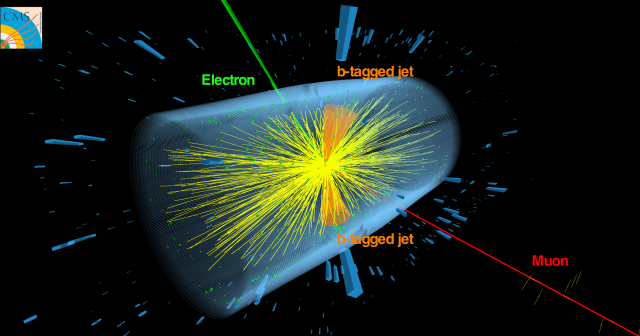Oct 12 2020
The CMS collaboration has observed signs for the existence of top quarks during collisions between heavy nuclei at the Large Hadron Collider (LHC).
 CMS candidate event for a top quark and antitop quark producing an electron, a muon, and jets originating from bottom (b) quarks. Image Credit: CERN.
CMS candidate event for a top quark and antitop quark producing an electron, a muon, and jets originating from bottom (b) quarks. Image Credit: CERN.
This unique particle—the heaviest known elementary particle—has already “made an appearance” at particle colliders. It was 25 years ago when the top quark was first seen during proton–antiproton collisions at the Tevatron collider. Since then, it has been observed and analyzed during proton–nucleus and proton–proton collisions at the LHC.
However, the results of the new study, elaborated in a paper that was very recently accepted for publication in Physical Review Letters, will surely inspire theorists and experimentalists equally. This is because analysis of top quarks during heavy-nuclei collisions provides new and exclusive means to probe the quark–gluon plasma that forms as part of these collisions and is considered to have existed in the early moments of the universe.
Moreover, analyses such as these could throw new light on the arrangement of gluons and quarks within heavy nuclei.
The particles, or “probes”, used to study the quark–gluon plasma are actually abundant. For a long time, the LHC experiments have been employing various types of particles to analyze the properties of this extreme state of matter, where gluons and quarks are not restricted to composite particles but roam similar to particles in a liquid with small frictional resistance.
However, time-averaged information related to the plasma is offered by all of the existing probes. On the other hand, due to the specific way in which the top quark “decays” or changes into other particles, it can offer a quick glance of the plasma at various time instances of its lifetime.
Faster-moving top quarks provide later-time snapshots. By assembling snapshots taken with top quarks at a range of different speeds, we hope that it will eventually be possible to create a movie of the quark–gluon plasma’s evolution. The new CMS result represents the very first step down that road.
Guilherme Milhano, Researcher, CERN
Milhano co-authored a theoretical study on investigating the quark–gluon plasma with top quarks.
The CMS collaboration observed evidence of top quarks in a huge data sample from lead–lead collisions at a 5.02 TeV energy. The researchers looked for collisions that generate a top quark and a top antiquark.
Such quarks decay very fast into a bottom quark and a W boson, which in turn decay very fast into other particles. Physicists at the CMS searched for the specific case where the final decay products are charged leptons (electrons or their heavier cousins muons) and “jets” of multiple particles that emerge from bottom quarks.
Once these top–antitop collision events were isolated and counted, CMS evaluated the probability for lead–lead collisions to generate top–antitop pairs through bottom quarks and charged leptons.
The statistical significance of the result is around four standard deviations, and thus it does not go beyond the threshold of five standard deviations needed to claim the observation of top-quark generation. However, it demonstrates crucial evidence of the process—the chance that the result is a statistical fluke is only 0.003%.
Furthermore, the result is in agreement with theoretical hypotheses, and also with extrapolations of earlier measurements of the probability in proton–proton collisions at the same collision energy.
Our result demonstrates the capability of the CMS experiment to perform top-quark studies in the complex environment of heavy-nuclei collisions, and it’s the first stepping stone in using the top quark as a new and powerful probe of the quark–gluon plasma.
Georgios Krintiras, Postdoctoral Researcher, University of Kansas
Krintiras is also a physicist at CMS.